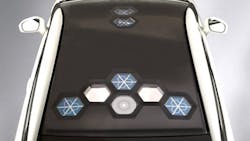Building a Better Satellite Antenna for Connected Cars
The technology for connected cars hasn’t quite caught up with the possibilities. Before cars can have deep, meaningful conversations with each other and the world--and drive by themselves en masse and build high-definition maps in real time--there are still some problems to solve. Like, how to transmit constellations of data back and forth from a moving object to a central location in nanoseconds, or how to keep cybercriminals from hacking into your dashboard and sending you barreling down a mountain.
LTE has its limitations: it’s a patchwork of regional coverage areas, with many entry points for hackers. Satellite covers the earth and has millions fewer holes—and if you need to patch those holes, you can dispatch a fix directly to everyone from one central location, rather than have to deal with regional networks. But unless you’re a cartoon character or tornado chaser, tacking a giant satellite dish to your car might get you fast-tracked to the international hall of bad ideas.
Nathan Kundtz, a physicist turned tech entrepreneur, came up with an potentially game-changing alternative to the satellite dish while a postdoc at Duke University: an electronically skinned flat-panel antenna using LED technology that stretches over the car roof. Instead of a huge, clunky piece of equipment. you get a smart device that uses software to scan and send signals only in the specific direction you want
The idea got traction while Kundtz was still at Duke, attracting investment from Intellectual Ventures, who recruited him to commercialize the business. The resulting startup, Kymeta, launched in 2012, is based in Redmond, Wash., and has about 110 employees. Intellectual Ventures, based in nearby Bellevue and led by former Microsoft CTO Nathan Myhrvold, brought Kuntz in a number of times to talk to Bill Gates about the potential of the technology for developing countries—mobile hospitals and classrooms, for instance.
Development help from Toyota and a production partnership with Sharp “where we can literally take a line that makes televisions in the morning and turn it into one that makes antennas in the afternoon” followed.
The LED technology keeps the cost down. A military precursor, called a phaser antenna, “is larger—the architecture is completely different—and they use very expensive components that typically require exotic materials,” says Kuntz, who is Kymeta’s CEO. “We do not.”
In January, Kymeta and Toyota jointly debuted the sleek, honeycomb-patterned panel on the Mirai hydrogen-celled vehicle at the 2016 Detroit Auto Show. The crowd at the press conference was relatively small, but the splash was big. Two weeks later, investors led by Gates and the Kresge Foundation poured $62 million into Kymeta.
Kymeta has also been developing maritime and aviation applications for the technology, including tracking equipment on engines and weather tracking. A week before the Auto Show, Panasonic announced a large purchase order of a version of the antenna for its maritime business. And in aviation, Kymeta has been partnering in development with Inmarcet.
“Applications span—and I don’t mean this with excessive hubris—everything that moves,” says Kundtz.
About the Author

Laura Putre
Senior Editor, IndustryWeek
As senior editor, Laura Putre works with IndustryWeek's editorial contributors and reports on leadership and the automotive industry as they relate to manufacturing. She joined IndustryWeek in 2015 as a staff writer covering workforce issues.
Prior to IndustryWeek, Laura reported on the healthcare industry and covered local news. She was the editor of the Chicago Journal and a staff writer for Cleveland Scene. Her national bylines include The Guardian, Slate, Pacific-Standard and The Root.
Laura was a National Press Foundation fellow in 2022.
Got a story idea? Reach out to Laura at [email protected]
